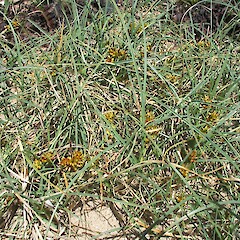Carex pumila
Common name
sand sedge
Synonyms
Carex littorea Labill.; Carex pumila Thunb. subsp. littorea (Labill.) Kük.
Family
Cyperaceae
Flora category
Vascular – Native
Endemic taxon
No
Endemic genus
No
Endemic family
No
Structural class
Sedges
NVS code
The National Vegetation Survey (NVS) Databank is a physical archive and electronic databank containing records of over 94,000 vegetation survey plots - including data from over 19,000 permanent plots. NVS maintains a standard set of species code abbreviations that correspond to standard scientific plant names from the Ngä Tipu o Aotearoa - New Zealand Plants database.
CARPUM
Chromosome number
2n = 82
Current conservation status
The conservation status of all known New Zealand vascular plant taxa at the rank of species and below were reassessed in 2017 using the New Zealand Threat Classification System (NZTCS) – more information about this can be found on the NZTCS website. This report includes a statistical summary and brief notes on changes since 2012 and replaces all previous NZTCS lists for vascular plants.
Please note, threat classifications are often suggested by authors when publications fall between NZTCS assessment periods – an interim threat classification status has not been assessed by the NZTCS panel.
- Conservation status of New Zealand indigenous vascular plants, 2017 . 2018. Peter J. de Lange, Jeremy R. Rolfe, John W. Barkla, Shannel P. Courtney, Paul D. Champion, Leon R. Perrie, Sarah M. Beadel, Kerry A. Ford, Ilse Breitwieser, Ines Schönberger, Rowan Hindmarsh-Walls, Peter B. Heenan and Kate Ladley. Department of Conservation. Source: NZTCS and licensed by DOC for reuse under the Creative Commons Attribution 4.0 International licence.
2017 | Not Threatened | Qualifiers: SO
Previous conservation statuses
2012 | Not Threatened
2009 | Not Threatened
2004 | Not Threatened
Distribution
Indigenous. New Zealand: North, South and Chatham Islands. Uncommon in parts of the South Island. Also recorded from Australia, Lord Howe Island, Chile, China, Japan and Korea.
Habitat
Mostly coastal, rarely extending inland. A species of mobile sand dunes, sand flats and dune slacks (swales). Sometimes found fringing the sandy margins of coastal rivers and lagoons. Occasionally found as an urban lawn weed, especially in coastal settlements.
Wetland plant indicator status rating
Information derived from the revised national wetland plant list prepared to assist councils in delineating and monitoring wetlands (Clarkson et al., 2021 Manaaki Whenua – Landcare Research Contract Report LC3975 for Hawke’s Bay Regional Council). The national plant list categorises plants by the extent to which they are found in wetlands and not ‘drylands’. The indicator status ratings are OBL (obligate wetland), FACW (facultative wetland), FAC (facultative), FACU (facultative upland), and UPL (obligate upland). If you have suggestions for the Wetland Indicator Status Rating, please contact: [Enable JavaScript to view protected content]
FAC: Facultative
Commonly occurs as either a hydrophyte or non-hydrophyte (non-wetlands).
Detailed description
Deep blue-green to glaucous, tufted sedge; tufts coarse, arising from a long, wiry creeping rhizome of c. 2 mm diameter. Culms mostly buried in sand, 50–300 mm long, terete, smooth, cream or light green, almost entirely enclosed by light brown or cream, occasionally red-brown leaf-sheaths. Leaves > culms, up to 400 mm long, 1.5–3 mm. wide, channelled, rigid, glaucous, curved and tapering to a fine point, margins mostly smooth. Spikes 3–8, ± approximate; terminal spike male, often long-pedunculate, very slender, often with 1–3 very small, occasionally partly female, spikes at the base; remaining spikes female, often male at the top, 10–35 × c. 10 mm. Glumes c. ½ length of utricles, rarely only slightly < utricles, ovate, acute, red-brown, with broad colourless hyaline margins, midrib very pale brown, thickened, usually produced to a short awn. Utricles 6.0–7.5 × 2.0–3.5 mm, biconvex to subtrigonous, ovoid, light brown, thick, corky, turgid, smooth or faintly nerved, narrowed to a bifid beak, 1.5–2.0 mm long, orifice membranous, crura faintly scabrid at tip. Stigmas 3. Nut 2.5–4.0 × 1.5–2.5 mm., trigonous, obovoid, light brown, shortly mucronate.
Similar taxa
None. The long, creeping, wiry rhizome, channeled, smooth-edged glaucous leaves and distinctly corky utricles are especially diagnostic.
Flowering
October–December
Fruiting
December–June
Life cycle
Spongy utricles dispersed by water and wind (Thorsen et al., 2009).
Propagation technique
Easily grown from fresh seed and by division of established plants. Will grow in most soils and conditions but does best in a freely draining medium in full sun. Some wild populations rarely set seed, and some selection of wild forms is merited. An excellent and highly under-rated sand binder.
Etymology
carex: Latin name for a species of sedge, now applied to the whole group.
pumila: Small
Attribution
Fact Sheet prepared for NZPCN by P.J. de Lange (110 August 2006). Description adapted from Moore and Edgar (1970)
References and further reading
Moore LB, Edgar E. 1970. Flora of New Zealand, Volume II. Indigenous Tracheophyta: Monocotyledones except Gramineae. Government Printer, Wellington, NZ. 354 p.
Thorsen MJ, Dickinson KJM, Seddon PJ. 2009. Seed dispersal systems in the New Zealand flora. Perspectives in Plant Ecology, Evolution and Systematics 11: 285–309.
NZPCN Fact Sheet citation
Please cite as: de Lange, P.J. (Year at time of access): Carex pumila Fact Sheet (content continuously updated). New Zealand Plant Conservation Network. https://www.nzpcn.org.nz/flora/species/carex-pumila/ (Date website was queried)








